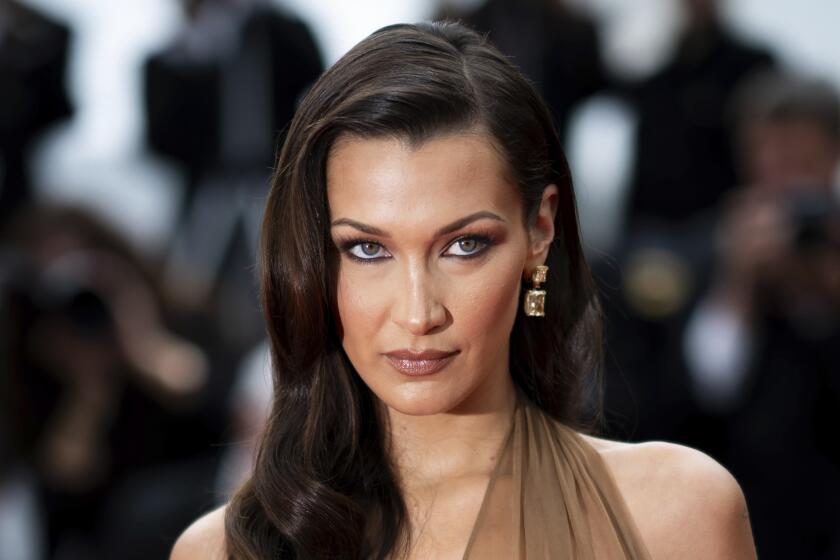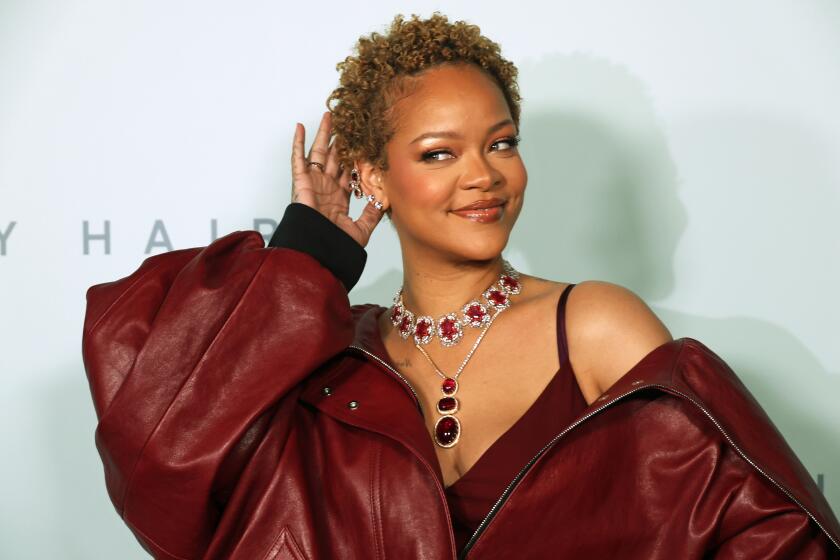MTV Begets Labels on Rags as Well as Rock, Rap, Reggae
Instead of looking to Paris for the latest trends, turn on MTV. Watch the colorful panorama of fashion across the screen and then feel the vibe on the street. It makes a very harmonious picture.
Music and fashion have long been intertwined--Josephine Baker and cloche hats, Frank Sinatra and sharkskin suits, Elvis Presley and brothel creepers, Jimi Hendrix and dashiki tops, Donovan and Nehru jackets, Janis Joplin and hip-huggers, Sid Vicious and bondage pants . . . .
More recently, sound waves have been washing up on fashion’s shore so quickly that they’ve become buzz words, i.e. hip-hop and grunge. Once satisfied to inspire fashion trends, some music megastars now prefer to produce their own labels--and we’re not talking records.
All the beats seem to be covered--from rap to rock to reggae. Chris Blackwell, founder of Island Records, backs retail and wholesale ventures. Rap impresario Russell Simmons opened a flagship store last April in SoHo for his Phat collection. Even individual artists such as Play of Kid N’Play, Public Enemy’s Chuck D and Jerry Garcia of the Grateful Dead are getting into the act.
Despite its competitive nature, the fashion world seems to be embracing these new players. Top designers seat them at runway shows, and retailers vie for their creations.
“There’s always been a synergy between fashion and music. Now it’s more prevalent than ever,” says Kal Ruttenstein, senior vice president of fashion direction at Bloomingdale’s. “Music people go out at night. They know what should be there and see what’s missing. They have all the right stimuli to create exciting fashion.”
Whether acting as financial backer, designer or something in between, the takes on fashion by this musical cast have at least one common thread: The clothes reflect the music.
“Just by its name, Island evokes an image. And we’ve carried it through to the fashion,” says Blackwell from his home in Jamaica. Island Trading Co. clothing, a wholesale and retail venture of Blackwell and designer Mary Vinson, features a vibrant mix of Third World fabrications in classic unisex shapes.
A key element, Blackwell says, is to generate income in Third World countries and to create “our own retail environment, which is that mix of Third World art, fashion and music. But my associate, John Baker, before any of us, has been in fashion and music and the mixture of the two.”
Baker, founder of Island subsidiary called Gee Street Records (think P.M. Dawn), has a Gee Street clothing line set to debut this fall. It reflects the label’s hip-hop roster in utility clothes with a message--be it gun control, ecology or anti-drugs.
Rap’s reigning king, Russell Simmons, lives large with a $50 million empire but is determined to bring authentic hip-hop clothes into pop culture just as he did with music.
“You see, real hip-hoppers don’t wear Cross Colours. Some hip-hop fans do, but certainly no artists,” says Simmons, dressed in his own Phat designs of loose jeans and sweat shirt.
Now at its own store in New York’s SoHo, Simmons says Phat is “not just for black people. It’s for people who consume black culture.”
Rageman Chuck D of Public Enemy has had a fashionable thing going for more than two years. After conquering the mail-order business, he’s going wholesale with Rapp Style, unisex sportswear color coordinated from head to toe. Suede hi-tops finish the look.
Rapp Style is expected to generate more than $5 million this year with national billing, including JC Penney, Nordstrom and Tower Records.
For Chuck D, it’s very definitely a matter of African-Americans owning what they create. “I sold more Raiders caps than the Raiders sold themselves, and I just got tired,” he says.
Monica Lynch, president of Tommy Boy Records, launched a Tommy Boy line last fall. It is designed with Albee Ragusa and distributed by Rock Embassy. Instead of the usual black bomber with leather sleeves, Tommy Boy did a brown Carhartt promotional jacket embroidered by Shawn Stussy of Irvine-based Stussy. The buzz led to testing the waters with jackets, sweat shirts, T-shirts and hats.
“Whether you’re a woman who wears a Chanel jacket or a kid who wears a Tommy Boy jacket, you’re trying to accomplish the same thing: You’re telling the world where you stand and who you’re down with,” Lynch says.
Mike Diamond of the Beastie Boys is attempting a refined hip-hop look with the X-Large label and a Los Angeles outlet he owns with two friends. Nothing in the store, he says, is more than $80.
Unlike his contemporaries, Christopher Martin, or “Play” of Kid N’Play, always wanted to be a designer. “Music just took off first,” says the co-star of the “House Party” movies.
For more than three years, Martin has quietly designed custom leather from his retail store in Queens. He recently launched a more casual line called Street Degree. He’s also co-designing a collection called Flipside, rap-related styles for Starter Sportswear, a $250-million company known for licensed apparel featuring pro sports logos.
Jerry Garcia is allowing Stonehenge to produce neckties and scarves with images from his paintings and lithographs.
Only time will tell if art, fashion and music are really one. While they borrow from each other, more recently the fashion leaders are taking their cues from music.
“I take my hat off to the designers for recognizing the importance of street fashion,” says Ruttenstein, adding that Bloomingdale’s has seen the light and opened a boutique with oversized, hip-hop clothes. “The influence of music is crossing boundaries no one ever expected. Even 50-year-old Beverly Hills ladies are wearing the look.”
The complete guide to home viewing
Get Screen Gab for everything about the TV shows and streaming movies everyone’s talking about.
You may occasionally receive promotional content from the Los Angeles Times.



